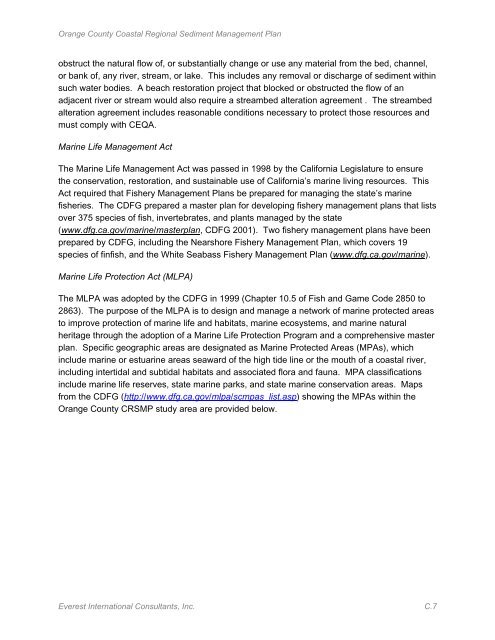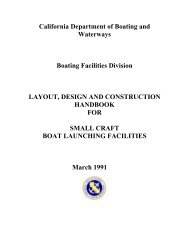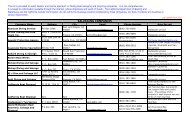EVEREST June, 2013 - California Department of Boating and ...
EVEREST June, 2013 - California Department of Boating and ...
EVEREST June, 2013 - California Department of Boating and ...
You also want an ePaper? Increase the reach of your titles
YUMPU automatically turns print PDFs into web optimized ePapers that Google loves.
Orange County Coastal Regional Sediment Management Plan<br />
obstruct the natural flow <strong>of</strong>, or substantially change or use any material from the bed, channel,<br />
or bank <strong>of</strong>, any river, stream, or lake. This includes any removal or discharge <strong>of</strong> sediment within<br />
such water bodies. A beach restoration project that blocked or obstructed the flow <strong>of</strong> an<br />
adjacent river or stream would also require a streambed alteration agreement . The streambed<br />
alteration agreement includes reasonable conditions necessary to protect those resources <strong>and</strong><br />
must comply with CEQA.<br />
Marine Life Management Act<br />
The Marine Life Management Act was passed in 1998 by the <strong>California</strong> Legislature to ensure<br />
the conservation, restoration, <strong>and</strong> sustainable use <strong>of</strong> <strong>California</strong>’s marine living resources. This<br />
Act required that Fishery Management Plans be prepared for managing the state’s marine<br />
fisheries. The CDFG prepared a master plan for developing fishery management plans that lists<br />
over 375 species <strong>of</strong> fish, invertebrates, <strong>and</strong> plants managed by the state<br />
(www.dfg.ca.gov/marine/masterplan, CDFG 2001). Two fishery management plans have been<br />
prepared by CDFG, including the Nearshore Fishery Management Plan, which covers 19<br />
species <strong>of</strong> finfish, <strong>and</strong> the White Seabass Fishery Management Plan (www.dfg.ca.gov/marine).<br />
Marine Life Protection Act (MLPA)<br />
The MLPA was adopted by the CDFG in 1999 (Chapter 10.5 <strong>of</strong> Fish <strong>and</strong> Game Code 2850 to<br />
2863). The purpose <strong>of</strong> the MLPA is to design <strong>and</strong> manage a network <strong>of</strong> marine protected areas<br />
to improve protection <strong>of</strong> marine life <strong>and</strong> habitats, marine ecosystems, <strong>and</strong> marine natural<br />
heritage through the adoption <strong>of</strong> a Marine Life Protection Program <strong>and</strong> a comprehensive master<br />
plan. Specific geographic areas are designated as Marine Protected Areas (MPAs), which<br />
include marine or estuarine areas seaward <strong>of</strong> the high tide line or the mouth <strong>of</strong> a coastal river,<br />
including intertidal <strong>and</strong> subtidal habitats <strong>and</strong> associated flora <strong>and</strong> fauna. MPA classifications<br />
include marine life reserves, state marine parks, <strong>and</strong> state marine conservation areas. Maps<br />
from the CDFG (http://www.dfg.ca.gov/mlpa/scmpas_list.asp) showing the MPAs within the<br />
Orange County CRSMP study area are provided below.<br />
Everest International Consultants, Inc. C.7




